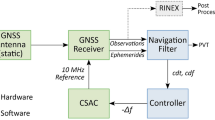Abstract
X-ray pulsar navigation (XPNAV) is an attractive method for autonomous navigation of deep space in the future. Currently, techniques for estimating the phase of X-ray pulsar radiation involve the maximization of the general non-convex object functions based on the average profile from the epoch folding method. This results in the suppression of useful information and highly complex computation. In this paper, a new maximum likelihood (ML) phase estimation method that directly utilizes the measured time of arrivals (TOAs) is presented. The X-ray pulsar radiation will be treated as a cyclo-stationary process and the TOAs of the photons in a period will be redefined as a new process, whose probability distribution function is the normalized standard profile of the pulsar. We demonstrate that the new process is equivalent to the generally used Poisson model. Then, the phase estimation problem is recast as a cyclic shift parameter estimation under the ML estimation, and we also put forward a parallel ML estimation method to improve the ML solution. Numerical simulation results show that the estimator described here presents a higher precision and reduces the computational complexity compared with currently used estimators.
Similar content being viewed by others
References
Ashby, N., Golshan, A.R., 2008. Minimum uncertainties in position and velocity determination using X-ray photons from millisecond pulsars. Proc. Institute of Navigation, National Technical Meeting, p.110–118.
Bar-Itzhack, I.Y., Oshman, Y., 1985. Attitude determination from vector observations: quaternion estimation. IEEE Trans. Aerosp. Electron. Syst., AES-21(1):128–136. [doi:10.1109/TAES.1985.310546]
Benedetto, F., Giunta, G., Lohan, E.S., et al., 2013. A fast unambiguous acquisition algorithm for BOC-modulated signals. IEEE Trans. Veh. Technol., 62(3):1350–1355. [doi:10.1109/TVT.2012.2228681]
Billing-Ross, J., Fritz, T., Pledger, D., 1992. Ultraviolet three axis attitude sensor. Annual AIAA/Utah State University Conf. on Small Satellites, p.1–5.
Blackburn, J.K., Greene, E.A., Pence, W., 1993. FTOOLS: a FITS data processing and analysis software package. Bull. Am. Astron. Soc., 25:816.
Chubei, M.S., Kovalchuk, L.V., Kholodova, S.I., et al., 2007. Star sensor for independent navigation in deep space. J. Opt. Technol., 74(2):107–114. [doi:10.1364/JOT.74.000 107]
Colonnese, S., Rinauro, S., Scarano, G., 2010. Generalized method of moments estimation of location parameters: application to blind phase acquisition. IEEE Trans. Signal Process., 58(9):4735–4749. [doi:10.1109/TSP.2010.2050316]
Downs, G.S., 1974. Interplanetary Navigation Using Pulsating Radio Sources. N/4-34150. NASA Technical Reports.
Emadzadeh, A.A., Speyer, J.L., 2010. On modeling and pulse phase estimation of X-ray pulsars. IEEE Trans. Signal Process., 58(9):4484–4495. [doi:10.1109/TSP.2010.2050479]
Emadzadeh, A.A., Speyer, J.L., 2011. Relative navigation between two spacecraft using X-ray pulsars. IEEE Trans. Contr. Syst. Technol., 19(5):1021–1035. [doi:10.1109/TCST.2010.2068049]
Hanson, J., Sheikh, S., Graven, P., et al., 2008. Noise analysis for X-ray navigation systems. Position, Location and Navigation Symp., IEEE/ION, p.704–713. [doi:10.1109/PLANS.2008.4570028]
Hobbs, G., Lyne, A., Kramer, M., 2006. Pulsar timing noise. Chin. J. Astron. Astrophys., 6(S2):169–175. [doi:10.1088/1009-9271/6/S2/31]
Kay, S.M., 1998. Fundamentals of Statistical Signal Processing, Volume 1: Estimation Theory. Prentice Hall PTR.
Kramer, M., 1994. Geometrical analysis of average pulsar profiles using multicomponent Gaussian fits ant several frequencies: II. individual results. Astron. Astrophys, 107:527–539.
Li, J.X., Ke, X.Z., 2011. Maximum-likelihood TOA estimation of X-ray pulsar signals on the basis of Poison model. Chin. Astron. Astrophys., 35(1):19–28. [doi:10.1016/j.china stron.2011.01.003]
Lyne, A.G., Smith, F.G., 1998. Pulsar Astronomy. Cambridge University Press, Cambridge, UK.
Ma, J., 2005. A method of autonomous orbit determination for satellite using star sensor. Sci. China Ser. G, 48(3):268. [doi:10.1360/142004-23]
Manchester, R.N., Taylor, J.H., 1977. Pulsars. W.H. Freeman, San Francisco.
Psiaki, M.L., 2011. Absolute orbit and gravity determination using relative position measurements between two satellites. J. Guid. Contr. Dynam., 34(5):1285–1297.
Ray, P.S., Wood, K.S., Phlips, B.F., 2006. Spacecraft navigation using X-ray pulsars. NRL Rev., p.95–102.
Ray, P.S., Sheikh, S.I., Graven, P.H., et al., 2008. Deep space navigation using celestial X-ray sources. Proc. Institute of Navigation, National Technical Meeting, p.101–109.
Ray, P.S., Kerr, M., Parent, D., et al., 2011. Precise gamma-ray timing and radio observations of 17 Fermi gamma-ray pulsars. Astrophys. J. Suppl. Ser., 194(2):17. [doi:10. 1088/0067-0049/194/2/17]
Rinauro, S., Colonnese, S., Scarano, G., 2013. Fast near-maximum likelihood phase estimation of X-ray pulsars. Signal Process., 93(1):326–331. [doi:10.1016/j.sigpro.2012.07.002]
Sala, J., Andreu, U., Xavier, V., 2004. Feasibility Study for a Spacecraft Navigation System Relying on Pulsar Timing Information. ARIADNA Study 03/4202. European Space Agency Advanced Concepts Team.
Sheikh, S.I., 2005. The use of variable celestial X-ray sources for spacecraft navigation. University of Maryland, College Park, Maryland, United States. Available from http://adsabs.harvard.edu/abs/2005PhDT........30S.
Sheikh, S.I., Pines, D.J., 2006. Recursive estimation of spacecraft position and velocity using X-ray pulsar time of arrival measurements. J. Inst. Navig., 53(3):149–166.
Sheikh, S.I., Pines, D.J., Wood, K.S., et al., 2007. Navigational System and Method Utilizing Sources of Pulsed Celestial Radiation. Available from http://www.google.com/patents?id=31J_AAAAEBAJ.
Xu, X.B., Wu, X.J., 2003. Mean pulse analysis and spectral character study of pulsar PSR B2111+46. Sci. China Ser. G, 46(1):104–112.
Zhang, H., Xu, L.P., 2011. An improved phase measurement method of integrated pulse profile for pulsar. Sci. China Technol. Sci., 54(9):2263–2270. [doi:10.1007/s11431-011-4524-8]
Zhang, H., Xu, L.P., Xie, Q., 2011. Modeling and Doppler measurement of X-ray pulsar. Sci. China Phys. Mech. Astron., 54(6):1068–1076. [doi:10.1007/s11433-011-43 38-5]
Author information
Authors and Affiliations
Corresponding author
Additional information
Project supported by the National Natural Science Foundation of China (No. 61172138), the Fundamental Research Funds for the Central Universities (Nos. K5051302015 and K5051302040), the Natural Science Basic Research Plan in Shaanxi Province of China (No. 2013JQ8040), and the Research Fund for the Doctoral Program of Higher Education of China (No. 20130203120004)
Rights and permissions
About this article
Cite this article
Zhang, H., Xu, Lp., Shen, Yh. et al. A new maximum-likelihood phase estimation method for X-ray pulsar signals. J. Zhejiang Univ. - Sci. C 15, 458–469 (2014). https://doi.org/10.1631/jzus.C1300347
Received:
Accepted:
Published:
Issue Date:
DOI: https://doi.org/10.1631/jzus.C1300347




